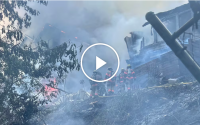How a Tiny Arts Center Is Helping a Rural County Heal After Wildfires
Just north of Napa Valley, famous for its picture-perfect wineries and inviting restaurants, is a California county with a far less flattering reputation.
Lake County, roughly 100 miles north of San Francisco with a population of about 68,000, has some of the state’s highest rates of poverty, unemployment and opioid deaths. The Los Angeles Times wrote in 2014 that the struggling rural county, named for the giant lake that it surrounds, looked as if it were “plucked from Appalachia — with weeds and unpaved streets, stray dogs and backyard marijuana crops.”
Bad luck has made matters worse. A series of devastating wildfires roared through Lake County between 2012 and 2018, burning more than half of the land.
But in the small mountain town of Middletown, population 700, an arts center has stepped up to help the region recover from the wildfires — and, more recently, from the pandemic.
Helen Whitney, a resident of Cobb, another small Lake County town, told me that the exhibits, workshops and craft fairs at the nonprofit Middletown Art Center have turned it into a “focal point for the area’s resilience and growth.”
Lake County residents typically don’t have much access to the arts, and “the MAC,” as residents call it, was born out of a call by local artists for a space to show, teach and create art, according to Lisa Kaplan, co-founder and director of the center. It opened in early 2015 in a renovated gymnasium.
A few months after the MAC’s first exhibit in March 2015, the Valley fire, one of the most destructive in California history, tore through Lake County, killing four people and leveling over a thousand houses. President Barack Obama declared the county a disaster area.
Kaplan’s house burned down, and many of the MAC’s artists and board members lost homes, studios or workplaces. But the MAC remained standing.
So instead of canceling an art class scheduled to take place a few weeks after the fire, Kaplan decided that the center might offer a refuge after so much devastation. The class was a success.
She realized then, she said, that “this could be something really healing for the community.”
Fast-moving wildfires fueled by an extended statewide drought kept battering the region, with the Mendocino Complex fire ravaging the northern part of Lake County in 2018.
The arts center began hosting farmers’ markets and craft fairs with open-mic entertainment. In 2020, the MAC expanded its art workshops again, bringing in a virtual audience so people could participate during Covid lockdowns.
“Zoom gave us this whole new landscape to work with, in terms of connecting,” Kaplan told me.
Over the years, the MAC has offered classes in photography, creative writing, painting and printmaking, in part to help people grieve or process survivor’s guilt. The center has held Valley fire anniversary shows, with local artists’ sculptures of spindly charred trees and paintings of orange infernos. And it has published books of poetry written by community members about the trauma of the blazes and how they survived. Right now it has an exhibit of Latino art.
When I visited the MAC recently, the road I took to Middletown wound through a lovely, grassy valley. Yet I was struck by the signs of fire that were still visible years later. Both sides of the road were dotted with grazing horses, but also with groves of tall, scorched trees.
What we’re recommending
27 works of fiction coming this spring.
Tell us
We’ve been compiling our California soundtrack for years, and have captured most of the hits. What songs do you think still need to be added?
Tell us at [email protected]. Please include your name, the city where you live, and a few sentences on why you think your song deserves to be included.
And before you go, some good news
On Valentine’s Day, scientists at the Birch Aquarium at the Scripps Institution of Oceanography in La Jolla spent the day playing matchmaker to two sunflower sea stars, members of a species that has nearly become extinct in the last decade.
The romantic meeting, if you will, was facilitated by Melissa Torres and her colleagues at the aquarium, and was covered in a recent New York Times article. The scientists wanted to see if they could fertilize eggs from the female sea star with both fresh and frozen semen from the male.
Sunflower sea stars are important to ocean ecology in the Pacific Northwest. They can keep the region’s kelp forests healthy by preying on sea urchins that eat through the forests’ algae. Since 2013, though, about 90 percent of the sea star population has died off, mostly because of warm sea temperatures.
But love was in the air on Feb. 14, and the team in La Jolla was able to fertilize millions of eggs that have since been distributed to the aquarium and other research centers involved in conservation efforts. By late February, some of those eggs had progressed to the larval stage — and they’re still growing.


